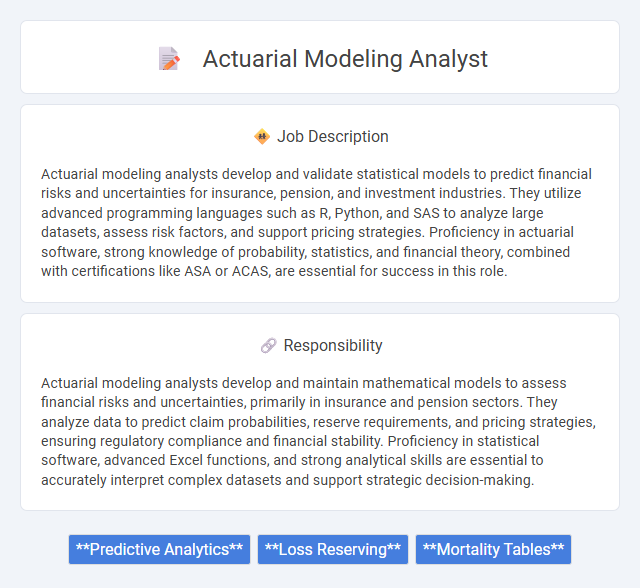
Actuarial modeling analysts develop and validate statistical models to predict financial risks and uncertainties for insurance, pension, and investment industries. They utilize advanced programming languages such as R, Python, and SAS to analyze large datasets, assess risk factors, and support pricing strategies. Proficiency in actuarial software, strong knowledge of probability, statistics, and financial theory, combined with certifications like ASA or ACAS, are essential for success in this role.
Individuals with strong quantitative skills and a passion for data analysis are likely to find a career as an actuarial modeling analyst suitable. Those who enjoy problem-solving, have attention to detail, and possess knowledge in mathematics, statistics, and finance probably have a higher chance of success in this role. Candidates who prefer structured environments and can work well under pressure may be more inclined to thrive in this profession.
Qualification
Actuarial modeling analyst roles demand a strong foundation in mathematics, statistics, and financial theory, typically supported by a degree in actuarial science, mathematics, or a related field. Proficiency in programming languages such as Python, R, or SQL is crucial for building and validating complex models that assess risk and forecast financial outcomes. Professional certifications from bodies like the Society of Actuaries (SOA) or the Casualty Actuarial Society (CAS) significantly enhance job prospects and demonstrate expertise in actuarial principles and practices.
Responsibility
Actuarial modeling analysts develop and maintain mathematical models to assess financial risks and uncertainties, primarily in insurance and pension sectors. They analyze data to predict claim probabilities, reserve requirements, and pricing strategies, ensuring regulatory compliance and financial stability. Proficiency in statistical software, advanced Excel functions, and strong analytical skills are essential to accurately interpret complex datasets and support strategic decision-making.
Benefit
Actuarial modeling analyst roles likely offer significant benefits such as competitive salaries and opportunities for career advancement within finance and insurance sectors. Professionals in this position probably gain valuable experience in risk assessment, predictive analytics, and data interpretation that enhance their expertise. Employers might also provide continuous training and certifications, which can improve long-term job security and professional growth.
Challenge
Actuarial modeling analyst roles likely involve complex data interpretation and risk assessment challenges that require strong analytical and statistical skills. The position probably demands adapting to evolving regulations and integrating advanced technologies to enhance model accuracy and efficiency. Navigating these uncertainties may test problem-solving abilities and critical thinking throughout the modeling process.
Career Advancement
Actuarial modeling analysts develop and refine mathematical models to assess financial risks, playing a crucial role in insurance, finance, and pension industries. Career advancement often involves progressing to senior actuarial roles, such as Senior Actuary or Actuarial Manager, where leadership and strategic decision-making responsibilities increase. Obtaining professional certifications from bodies like the Society of Actuaries (SOA) or the Casualty Actuarial Society (CAS) significantly enhances promotion prospects and salary growth.
Key Terms
Predictive Analytics
Actuarial modeling analysts leverage predictive analytics to forecast risks and financial outcomes by analyzing historical data and identifying trends. They utilize advanced statistical techniques and machine learning algorithms to build models that inform pricing, reserving, and risk management decisions. Their expertise in predictive analytics enhances accuracy in projections and supports strategic planning within insurance and financial sectors.
Loss Reserving
Actuarial modeling analysts specializing in loss reserving develop statistical models to estimate future claim liabilities, ensuring accurate financial reporting for insurance companies. They analyze historical claims data using advanced techniques like chain-ladder and Bornhuetter-Ferguson methods to predict outstanding losses. Proficiency in programming languages such as R or Python and strong knowledge of insurance regulations are critical for effective loss reserving analysis.
Mortality Tables
Actuarial modeling analysts specializing in mortality tables utilize statistical methods to evaluate life expectancy trends and predict future mortality rates. They analyze demographic data to construct accurate life tables, which serve as crucial inputs for insurance pricing, pension planning, and risk management. Expertise in mortality tables enables these analysts to assess longevity risk and develop models that reflect population dynamics and health advancements.
 kuljobs.com
kuljobs.com